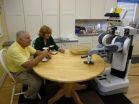(Press-News.org) Robots have the potential to help older adults with daily activities that can become more challenging with age. But are people willing to use and accept the new technology? A study by the Georgia Institute of Technology indicates the answer is yes, unless the tasks involve personal care or social activities.
After showing adults (ages 65 to 93 years) a video of a robot's capabilities, researchers interviewed them about their willingness for assistance with 48 common household tasks. Participants generally preferred robotic help over human help for chores such as cleaning the kitchen, doing laundry and taking out the trash. But when it came to help getting dressed, eating and bathing, the adults tended to say they would prefer human assistance over robot assistance. They also preferred human help for social activities, such as calling family and friends or entertaining guests.
Georgia Tech's Cory-Ann Smarr will present the results this week at the Human Factors Ergonomics Society Annual Meeting in Boston.
"There are many misconceptions about older adults having negative attitudes toward robots," said Smarr, a School of Psychology graduate teaching assistant. "The people we interviewed were very enthusiastic and optimistic about robots in their daily lives. They were also very particular in their preferences, something that can assist researchers as they determine what to design and introduce in the home."
Smarr and Psychology Professor Wendy Rogers, the principal investigator on the project, also noticed that preferences varied across tasks, such as medication. For instance, adults said they are willing to use a robot for reminders to take medicine, but they are more comfortable if a person helps them decide which medication to take.
"It seems that older people are less likely to trust a robot with decision-making tasks than with monitoring or physical assistance," said Rogers. "Researchers should be careful not to generalize preferences when designing assistive robots."
The older adults in the study were all healthy and independent, and nearly 75 percent said they used everyday technologies such as cell phones and appliances. Many said they don't need immediate assistance. The research team is planning future studies for adults who currently need help with everyday tasks.
INFORMATION:
This research was supported by the National Institutes of Health under grant PO1 AG17211. The content is solely the responsibility of the authors and does not necessarily represent the official views of the National lnstitutes of Health. The project is also supported by the National Science Foundation (NSF) (Award Number CBET-0932592 and CNS-0958545). The content is solely the responsibility of the principal investigators and does not necessarily represent the official views of the NSF.
Robots in the home: Will older adults roll out the welcome mat?
Identifying preferences for robotic assistance
2012-10-26
ELSE PRESS RELEASES FROM THIS DATE:
New genes discovered for adult BMI levels
2012-10-26
A large international study has identified three new gene variants associated with body mass index (BMI) levels in adults. The scientific consortium, numbering approximately 200 researchers, performed a meta-analysis of 46 studies, covering gene data from nearly 109,000 adults, spanning four ethnic groups.
In discovering intriguing links to lipid-related diseases, type 2 diabetes and other disorders, the IBC 50K SNP Array BMI Consortium's study may provide fundamental insights into the biology of adult obesity. Scientists from the Center for Applied Genomics at The Children's ...
Academia should fulfill social contract by supporting bioscience startups, case study says
2012-10-26
Universities not only provide the ideal petri dish for cultivating bioscience with commercial potential, but have a moral obligation to do so, given the opportunity to translate public funding into health and jobs, according to a new case study by UCSF researchers.
In an analysis published Oct. 24, 2012 in Science Translational Medicine, researchers at the California Institute for Quantitative Biosciences (QB3) assessed the impact of the institute's efforts over the past eight years in supporting entrepreneurs on the three UC campuses in which it operates: UCSF, UC Berkeley ...
Scientists deepen genetic understanding of MS
2012-10-26
Five scientists, including two from Simon Fraser University, have discovered that 30 per cent of our likelihood of developing Multiple Sclerosis (MS) can be explained by 475,806 genetic variants in our genome. Genome-wide Association Studies (GWAS) commonly screen these variants, looking for genetic links to diseases.
Corey Watson, a recent SFU doctoral graduate in biology, his thesis supervisor SFU biologist Felix Breden and three scientists in the United Kingdom have just had their findings published online in Scientific Reports. It's a sub-publication of the journal ...
Sharing space:
2012-10-26
A new University of Michigan study shows that when researchers share a building, and especially a floor, the likelihood of forming new collaborations and obtaining funding increases dramatically.
The findings have wide relevance to corporations, as well.
"Our analyses clearly show that there are benefits to co-location," said Jason Owen-Smith, an associate professor of sociology and organizational studies.
Researchers who occupy the same building are 33 percent more likely to form new collaborations than researchers who occupy different buildings, and scientists who ...
New study brings a doubted exoplanet 'back from the dead'
2012-10-26
A second look at data from NASA's Hubble Space Telescope is reanimating the claim that the nearby star Fomalhaut hosts a massive exoplanet. The study suggests that the planet, named Fomalhaut b, is a rare and possibly unique object that is completely shrouded by dust.
"Although our results seriously challenge the original discovery paper, they do so in a way that actually makes the object's interpretation much cleaner and leaves intact the core conclusion, that Fomalhaut b is indeed a massive planet," said Thayne Currie, an astronomer formerly at NASA's Goddard Space ...
NASA spacecraft sees huge burp at Saturn after large storm
2012-10-26
NASA's Cassini spacecraft has tracked the aftermath of a rare massive storm on Saturn. Data reveal record-setting disturbances in the planet's upper atmosphere long after the visible signs of the storm abated, in addition to an indication the storm was more forceful than scientists previously thought.
Data from Cassini's composite infrared spectrometer (CIRS) instrument revealed the storm's powerful discharge sent the temperature in Saturn's stratosphere soaring 150 degrees Fahrenheit (83 kelvins) above normal. At the same time, researchers at NASA's Goddard Space Flight ...
A clearer picture of how assassin bugs evolved
2012-10-26
RIVERSIDE, Calif. — Assassin bugs, so named because these insects lie in ambush for prey that they attack with speed and precision, are found all over the world. Nearly 140 species of these bugs are blood-sucking; because they can bite humans around the mouth, they are also called kissing bugs. All kissing bugs can spread Chagas disease, a neglected tropical disease that imposes an economic burden on society.
Surprising, then, that scientists' understanding of the evolutionary history of assassin bugs is riddled with difficulty. The data are incomplete. Fossils, which ...
High-risk carotid artery plaque formation is increased in older COPD patients
2012-10-26
Older patients with chronic obstructive pulmonary disease (COPD) are at increased risk for carotid artery plaque formation and for the presence of vulnerable plaques with a lipid core, according to a new study from researchers in the Netherlands.
"We know that COPD is a risk factor for ischemic stroke, and that certain components of carotid artery plaques such as intraplaque hemorrhage and lipid core increase the risk of ischemic events, but plaque composition in patients with COPD has not been examined," said researcher Bruno H.C. Stricker, MD, PhD, professor of pharmaco-epidemiology ...
Integrated diabetes management program provides rapid improvements in patient care
2012-10-26
Ottawa, October 26, 2012 - In Canada alone, almost 2 million people are known to be living with diabetes. And around a million more have the disease but are not aware of that fact, and have not been given the tools they need to control their blood sugar and safeguard their health. The Heart Institute will be presenting the results of an innovative pilot program on October 29, at the Canadian Cardiovascular Congress in Toronto, Canada.
Diabetic patients have a much greater risk of dangerous cardiovascular events, including recurrent heart attacks and development of heart ...
Tips to Help Establish Financial Security After Divorce
2012-10-26
A divorce marks more than just the end of a relationship; it also represents the end of a financial partnership. As a result, it is important to take a step back from the emotional side of the divorce and review the financial side both during and after the divorce proceeding.
Before a divorce is finalized, it is wise to attempt to develop a post-divorce budget. This will help you to determine what assets you need when determining marital property division in the divorce.
After the divorce is complete, take a moment to look over your new expenses and income. Review ...
LAST 30 PRESS RELEASES:
Beyond small data limitations: Transfer learning-enabled framework for predicting mechanical properties of aluminum matrix composites
Unveiling non-thermal catalytic origin of direct current-promoted catalysis for energy-efficient transformation of greenhouse gases to valuable chemicals
Chronic breathlessness emerging as a hidden strain on hospitals
Paleontologists find first fossil bee nests made inside fossil bones
These fossils were the perfect home for ancient baby bees
Not everyone reads the room the same. A new study examines why.
New research identifies linked energy, immune and vascular changes in ME/CFS
Concurrent frailty + depression likely boost dementia risk in older people
Living in substandard housing linked to kids’ missed schooling and poor grades
Little awareness of medical + psychological complexities of steroid cream withdrawal
Eight in 10 trusts caring for emergency department patients in corridors, finds BMJ investigation
NASA’s Webb telescope finds bizarre atmosphere on a lemon-shaped exoplanet
The gut bacteria that put the brakes on weight gain in mice
Exploring how patients feel about AI transcription
Category ‘6’ tropical cyclone hot spots are growing
Video: Drivers struggle to multitask when using dashboard touch screens, study finds
SLU research shows surge in alcohol-related liver disease driving ‘deaths of despair’
Rising heat reshapes how microbes break down microplastics, new review finds
Roots reveal a hidden carbon pathway in maize plants
Membrane magic: FAMU-FSU researchers repurpose fuel cells membranes for new applications
UN Member States pledge to increase access to diagnosis and inhaled medicines for the 480 million people living with COPD
Combination therapy shows potential to treat pediatric brain cancer ATRT
Study links seabird nesting to shark turf wars in Hawai‘i
Legal sports betting linked to sharp increases in violent crime, study finds
Breakthrough AI from NYUAD speeds up discovery of life-supporting microbes
New Eva Mayr-Stihl Foundation funding initiative boosts research at University of Freiburg on adaptation of forests to global change
The perfect plastic? Plant-based, fully saltwater degradable, zero microplastics
Bias in data may be blocking AI’s potential to combat antibiotic resistance
Article-level metrics would provide more recognition to most researchers than journal-level metrics
Satiety’s little helper: Protein that supports appetite regulating protein identified
[Press-News.org] Robots in the home: Will older adults roll out the welcome mat?Identifying preferences for robotic assistance



